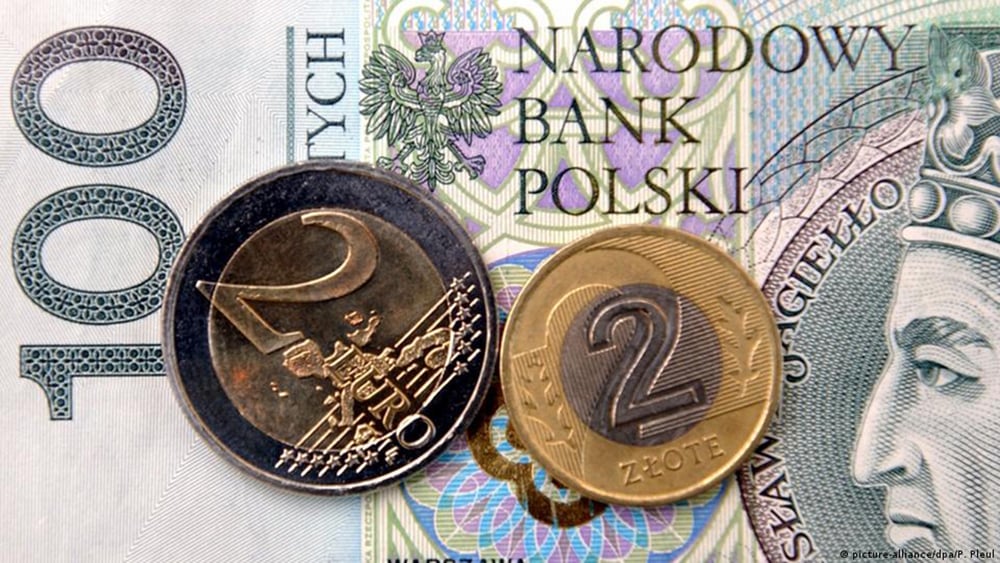The Hungarian forint is up 10% against the dollar this year, as are the Czech koruna, Polish zloty and Romanian leu. What is driving the strength of Eastern European currencies and will this trend continue?
The Czech koruna hit a 14-year high and the Hungarian forint hit a 10-month high earlier this year, boosted by high interest rates, falling energy prices and a strong euro. The Polish zloty and Romanian leu also rose despite shrinking economic activity.
 |
The Polish zloty rose to a 10-month high against both the euro and the dollar in late April. |
Observers have speculated about how this could happen and how long it could last.
Central and Eastern European (CEE) currencies – with the exception of Slovakia, which is outside the eurozone – benefit most from high interest rate differentials, known as real interest rates – calculated by subtracting the inflation rate from the nominal interest rate. CEE currencies currently look attractive compared to the interest rates of the ECB (European Central Bank) and the US Fed.
After rising to double-digit rates across CEE countries last year, inflation now appears to have peaked. However, interest rates remain high and central banks are in no hurry to ease policy until the pace of price increases is curbed.
As a result, the gap between inflation and interest rates has widened, making the region attractive to capital looking for higher yields. This has happened despite rising interest rates in the US and the eurozone.
Why are Central and Eastern European currencies performing so well?
Piotr Arak, Director of the Polish Institute of Economics (PIE), explained that as a rule of thumb, increased exports, cheaper energy, capital inflows due to higher interest rates will "lead to a stable currency."
“In recent quarters, there has been a significant improvement in the current account balance and exports as countries in the region continue to grow, while falling commodity prices have led to a reduction in the import burden,” Mr. Arak told DW (Germany).
In Poland, the central bank on May 10 kept its key interest rate unchanged at 6.75%, the same as last September, while inflation fell to 14.7% in April from 16.1% in March.
The governor of the National Bank of Poland, Adam Glapinski, said he expected inflation to fall to single digits by early September. This would make a rate cut possible later in the year provided inflation falls further.
However, ING bank monetary policy expert Rafal Benecki found that March data from the Polish economy was not a "pretty picture" in this respect, suggesting that current high interest rates are cooling the economy.
 |
Inflation in Hungary reached 25.4% in February. Pictured, customers shop at a Tesco supermarket in the Hungarian capital Budapest. |
Inflation remained broadly unchanged, suggesting that businesses were passing on higher costs to prices, and the fall in inflation was mainly due to the easing of the energy shock and downward pressure on food prices.
ING expects Poland's central bank to keep interest rates on hold later this year and cuts could start as early as 2024, meaning the zloty's short-term room for further appreciation may have "almost run out".
Meanwhile, since the beginning of this year, the Hungarian forint has strengthened 6.6% against the euro and 9.3% against the USD. The National Bank of Hungary (NBH) has kept its interest rate unchanged at 13% since October 2022.
However, most analysts believe Hungary could see its first rate cut later this year as its economy has been in technical recession for three consecutive quarters.
ING predicts the Hungarian economy will pick up in the second quarter of 2023, with full-year GDP growth of 0.7%. Despite the modest growth, the trade balance has benefited from lower energy prices, which has also supported the national currency.
Meanwhile, in Romania, the central bank kept its key interest rate unchanged at 7% in April. Economists expect rates to remain unchanged throughout 2023. The Romanian economy has shown relative resilience compared to other Central European countries.
As elsewhere in the region, inflation in Romania is quite high and the central bank forecast 7% in December. Therefore, a rate cut is unlikely.
In the Czech Republic, the koruna remains strong despite falling from a 15-year high against the euro in mid-April. Czech gross domestic product (GDP) grew 0.1% quarter-on-quarter in the first quarter, pulling the economy out of recession, boosted by trade.
 |
Analysts predict the current strength of the zloty and other currencies in Central and Eastern Europe will not last. |
Threats
PIE expert Piotr Arak believes that much of the growth in the value of currencies in CEE depends on the path of inflation, which is expected to remain high for a longer period than in the eurozone.
“This could lead to a weakening of purchasing power. In addition, the economic slowdown could lead to lower foreign investment and higher government deficits. Both factors would be negative,” Mr. Arak said.
PIE's analysis predicts that the current strength of the zloty and other CEE currencies will not last. "Our long-term forecasts suggest that these currencies are likely to depreciate. But there may be differences between countries."
However, overshadowing the outlook for national economies at the moment is the prospect of a US recession, which would also weigh on CEE currencies. Similarly, uncertainty remains over the health of the global banking system following a number of recent failures. Any stress could lead to a slowdown in capital inflows, particularly to emerging markets such as CEE countries.
According to VNA
Currency, inflation, economic growth, eastern europe, ukraine conflict, ukraine war
Source link


![[Photo] 60th Anniversary of the Founding of the Vietnam Association of Photographic Artists](/_next/image?url=https%3A%2F%2Fvphoto.vietnam.vn%2Fthumb%2F1200x675%2Fvietnam%2Fresource%2FIMAGE%2F2025%2F12%2F05%2F1764935864512_a1-bnd-0841-9740-jpg.webp&w=3840&q=75)




![[Photo] National Assembly Chairman Tran Thanh Man attends the VinFuture 2025 Award Ceremony](/_next/image?url=https%3A%2F%2Fvphoto.vietnam.vn%2Fthumb%2F1200x675%2Fvietnam%2Fresource%2FIMAGE%2F2025%2F12%2F05%2F1764951162416_2628509768338816493-6995-jpg.webp&w=3840&q=75)










































































































Comment (0)